Rectified 5-simplexes
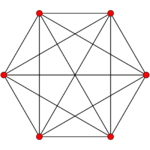 5-simplex |
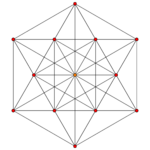 Rectified 5-simplex |
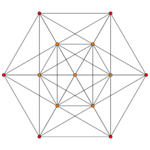 Birectified 5-simplex |
| Orthogonal projections in A5 Coxeter plane | ||
|---|---|---|
In five-dimensional geometry, a rectified 5-simplex is a convex uniform 5-polytope, being a rectification of the regular 5-simplex.
There are three unique degrees of rectifications, including the zeroth, the 5-simplex itself. Vertices of the rectified 5-simplex are located at the edge-centers of the 5-simplex. Vertices of the birectified 5-simplex are located in the triangular face centers of the 5-simplex.
Rectified 5-simplex
In five-dimensional geometry, a rectified 5-simplex is a uniform 5-polytope with 15 vertices, 60 edges, 80 triangular faces, 45 cells (30 tetrahedral, and 15 octahedral), and 12 4-faces (6 5-cell and 6 rectified 5-cells). It is also called 03,1 for its branching Coxeter-Dynkin diagram, shown as ![]()
![]()
![]()
![]()
![]()
![]()
![]() .
.
E. L. Elte identified it in 1912 as a semiregular polytope, labeling it as S15.
Alternate names
- Rectified hexateron (Acronym: rix) (Jonathan Bowers)
Coordinates
The vertices of the rectified 5-simplex can be more simply positioned on a hyperplane in 6-space as permutations of (0,0,0,0,1,1) or (0,0,1,1,1,1). These construction can be seen as facets of the rectified 6-orthoplex or birectified 6-cube respectively.
As a configuration
This configuration matrix represents the rectified 5-simplex. The rows and columns correspond to vertices, edges, faces, cells and 4-faces. The diagonal numbers say how many of each element occur in the whole rectified 5-simplex. The nondiagonal numbers say how many of the column's element occur in or at the row's element.[1][2]
The diagonal f-vector numbers are derived through the Wythoff construction, dividing the full group order of a subgroup order by removing one mirror at a time.[3]
| A5 | k-face | fk | f0 | f1 | f2 | f3 | f4 | k-figure | notes | ||||
|---|---|---|---|---|---|---|---|---|---|---|---|---|---|
| A3A1 | ( ) | f0 | 15 | 8 | 4 | 12 | 6 | 8 | 4 | 2 | {3,3}×{ } | A5/A3A1 = 6!/4!/2 = 15 | |
| A2A1 | { } | f1 | 2 | 60 | 1 | 3 | 3 | 3 | 3 | 1 | {3}∨( ) | A5/A2A1 = 6!/3!/2 = 60 | |
| A2A2 | r{3} | f2 | 3 | 3 | 20 | * | 3 | 0 | 3 | 0 | {3} | A5/A2A2 = 6!/3!/3! =20 | |
| A2A1 | {3} | 3 | 3 | * | 60 | 1 | 2 | 2 | 1 | { }×( ) | A5/A2A1 = 6!/3!/2 = 60 | ||
| A3A1 | r{3,3} | f3 | 6 | 12 | 4 | 4 | 15 | * | 2 | 0 | { } | A5/A3A1 = 6!/4!/2 = 15 | |
| A3 | {3,3} | 4 | 6 | 0 | 4 | * | 30 | 1 | 1 | A5/A3 = 6!/4! = 30 | |||
| A4 | r{3,3,3} | f4 | 10 | 30 | 10 | 20 | 5 | 5 | 6 | * | ( ) | A5/A4 = 6!/5! = 6 | |
| A4 | {3,3,3} | 5 | 10 | 0 | 10 | 0 | 5 | * | 6 | A5/A4 = 6!/5! = 6 | |||
Images
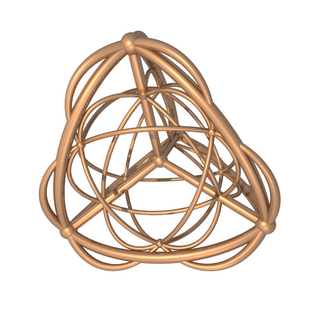 Stereographic projection of spherical form |
| Ak Coxeter plane |
A5 | A4 |
|---|---|---|
| Graph | 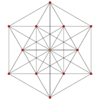
|
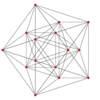
|
| Dihedral symmetry | [6] | [5] |
| Ak Coxeter plane |
A3 | A2 |
| Graph | 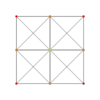
|
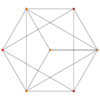
|
| Dihedral symmetry | [4] | [3] |
Related polytopes
The rectified 5-simplex, 031, is second in a dimensional series of uniform polytopes, expressed by Coxeter as 13k series. The fifth figure is a Euclidean honeycomb, 331, and the final is a noncompact hyperbolic honeycomb, 431. Each progressive uniform polytope is constructed from the previous as its vertex figure.
Birectified 5-simplex
The birectified 5-simplex is isotopic, with all 12 of its facets as rectified 5-cells. It has 20 vertices, 90 edges, 120 triangular faces, 60 cells (30 tetrahedral, and 30 octahedral).
E. L. Elte identified it in 1912 as a semiregular polytope, labeling it as S25.
It is also called 02,2 for its branching Coxeter-Dynkin diagram, shown as ![]()
![]()
![]()
![]()
![]() . It is seen in the vertex figure of the 6-dimensional 122,
. It is seen in the vertex figure of the 6-dimensional 122, ![]()
![]()
![]()
![]()
![]()
![]()
![]() .
.
Alternate names
- Birectified hexateron
- dodecateron (Acronym: dot) (For 12-facetted polyteron) (Jonathan Bowers)
Construction
The elements of the regular polytopes can be expressed in a configuration matrix. Rows and columns reference vertices, edges, faces, and cells, with diagonal element their counts (f-vectors). The nondiagonal elements represent the number of row elements are incident to the column element.[4][5]
The diagonal f-vector numbers are derived through the Wythoff construction, dividing the full group order of a subgroup order by removing one mirror at a time.[6]
| A5 | k-face | fk | f0 | f1 | f2 | f3 | f4 | k-figure | notes | |||||
|---|---|---|---|---|---|---|---|---|---|---|---|---|---|---|
| A2A2 | ( ) | f0 | 20 | 9 | 9 | 9 | 3 | 9 | 3 | 3 | 3 | {3}×{3} | A5/A2A2 = 6!/3!/3! = 20 | |
| A1A1A1 | { } | f1 | 2 | 90 | 2 | 2 | 1 | 4 | 1 | 2 | 2 | { }∨{ } | A5/A1A1A1 = 6!/2/2/2 = 90 | |
| A2A1 | {3} | f2 | 3 | 3 | 60 | * | 1 | 2 | 0 | 2 | 1 | { }∨( ) | A5/A2A1 = 6!/3!/2 = 60 | |
| A2A1 | 3 | 3 | * | 60 | 0 | 2 | 1 | 1 | 2 | |||||
| A3A1 | {3,3} | f3 | 4 | 6 | 4 | 0 | 15 | * | * | 2 | 0 | { } | A5/A3A1 = 6!/4!/2 = 15 | |
| A3 | r{3,3} | 6 | 12 | 4 | 4 | * | 30 | * | 1 | 1 | A5/A3 = 6!/4! = 30 | |||
| A3A1 | {3,3} | 4 | 6 | 0 | 4 | * | * | 15 | 0 | 2 | A5/A3A1 = 6!/4!/2 = 15 | |||
| A4 | r{3,3,3} | f4 | 10 | 30 | 20 | 10 | 5 | 5 | 0 | 6 | * | ( ) | A5/A4 = 6!/5! = 6 | |
| A4 | 10 | 30 | 10 | 20 | 0 | 5 | 5 | * | 6 | |||||
Images
The A5 projection has an identical appearance to Metatron's Cube.[7]
Intersection of two 5-simplices
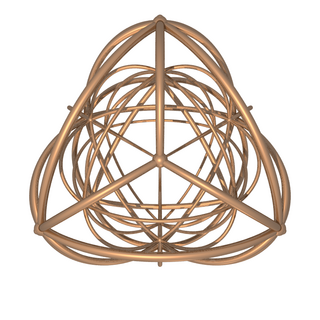
|
The birectified 5-simplex is the intersection of two regular 5-simplexes in dual configuration. The vertices of a birectification exist at the center of the faces of the original polytope(s). This intersection is analogous to the 3D stellated octahedron, seen as a compound of two regular tetrahedra and intersected in a central octahedron, while that is a first rectification where vertices are at the center of the original edges.
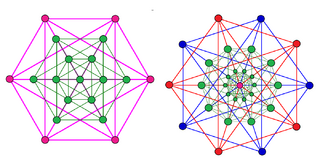
|
| Dual 5-simplexes (red and blue), and their birectified 5-simplex intersection in green, viewed in A5 and A4 Coxeter planes. The simplexes overlap in the A5 projection and are drawn in magenta. |
It is also the intersection of a 6-cube with the hyperplane that bisects the 6-cube's long diagonal orthogonally. In this sense it is the 5-dimensional analog of the regular hexagon, octahedron, and bitruncated 5-cell. This characterization yields simple coordinates for the vertices of a birectified 5-simplex in 6-space: the 20 distinct permutations of (1,1,1,−1,−1,−1).
The vertices of the birectified 5-simplex can also be positioned on a hyperplane in 6-space as permutations of (0,0,0,1,1,1). This construction can be seen as facets of the birectified 6-orthoplex.
Related polytopes
k_22 polytopes
The birectified 5-simplex, 022, is second in a dimensional series of uniform polytopes, expressed by Coxeter as k22 series. The birectified 5-simplex is the vertex figure for the third, the 122. The fourth figure is a Euclidean honeycomb, 222, and the final is a noncompact hyperbolic honeycomb, 322. Each progressive uniform polytope is constructed from the previous as its vertex figure.
Isotopics polytopes
Related uniform 5-polytopes
This polytope is the vertex figure of the 6-demicube, and the edge figure of the uniform 231 polytope.
It is also one of 19 uniform polytera based on the [3,3,3,3] Coxeter group, all shown here in A5 Coxeter plane orthographic projections. (Vertices are colored by projection overlap order, red, orange, yellow, green, cyan, blue, purple having progressively more vertices)
References
- ↑ Coxeter, Regular Polytopes, sec 1.8 Configurations
- ↑ Coxeter, Complex Regular Polytopes, p.117
- ↑ Klitzing, Richard. "o3x3o3o3o - rix". https://bendwavy.org/klitzing/dimensions/../incmats/rix.htm.
- ↑ Coxeter, Regular Polytopes, sec 1.8 Configurations
- ↑ Coxeter, Complex Regular Polytopes, p.117
- ↑ Klitzing, Richard. "o3o3x3o3o - dot". https://bendwavy.org/klitzing/dimensions/../incmats/dot.htm.
- ↑ Melchizedek, Drunvalo (1999). The Ancient Secret of the Flower of Life. 1. Light Technology Publishing. p.160 Figure 6-12
- H.S.M. Coxeter:
- H.S.M. Coxeter, Regular Polytopes, 3rd Edition, Dover New York, 1973
- Kaleidoscopes: Selected Writings of H.S.M. Coxeter, edited by F. Arthur Sherk, Peter McMullen, Anthony C. Thompson, Asia Ivic Weiss, Wiley-Interscience Publication, 1995, ISBN 978-0-471-01003-6 [1]
- (Paper 22) H.S.M. Coxeter, Regular and Semi Regular Polytopes I, [Math. Zeit. 46 (1940) 380-407, MR 2,10]
- (Paper 23) H.S.M. Coxeter, Regular and Semi-Regular Polytopes II, [Math. Zeit. 188 (1985) 559-591]
- (Paper 24) H.S.M. Coxeter, Regular and Semi-Regular Polytopes III, [Math. Zeit. 200 (1988) 3-45]
- Norman Johnson Uniform Polytopes, Manuscript (1991)
- N.W. Johnson: The Theory of Uniform Polytopes and Honeycombs, Ph.D.
- Klitzing, Richard. "5D uniform polytopes (polytera)". https://bendwavy.org/klitzing/dimensions/polytera.htm. o3x3o3o3o - rix, o3o3x3o3o - dot
External links
- Glossary for hyperspace, George Olshevsky.
- Polytopes of Various Dimensions, Jonathan Bowers
- Rectified uniform polytera (Rix), Jonathan Bowers
- Multi-dimensional Glossary
Fundamental convex regular and uniform polytopes in dimensions 2–10
| ||||||||||||
|---|---|---|---|---|---|---|---|---|---|---|---|---|
| Family | An | Bn | I2(p) / Dn | E6 / E7 / E8 / F4 / G2 | Hn | |||||||
| Regular polygon | Triangle | Square | p-gon | Hexagon | Pentagon | |||||||
| Uniform polyhedron | Tetrahedron | Octahedron • Cube | Demicube | Dodecahedron • Icosahedron | ||||||||
| Uniform 4-polytope | 5-cell | 16-cell • Tesseract | Demitesseract | 24-cell | 120-cell • 600-cell | |||||||
| Uniform 5-polytope | 5-simplex | 5-orthoplex • 5-cube | 5-demicube | |||||||||
| Uniform 6-polytope | 6-simplex | 6-orthoplex • 6-cube | 6-demicube | 122 • 221 | ||||||||
| Uniform 7-polytope | 7-simplex | 7-orthoplex • 7-cube | 7-demicube | 132 • 231 • 321 | ||||||||
| Uniform 8-polytope | 8-simplex | 8-orthoplex • 8-cube | 8-demicube | 142 • 241 • 421 | ||||||||
| Uniform 9-polytope | 9-simplex | 9-orthoplex • 9-cube | 9-demicube | |||||||||
| Uniform 10-polytope | 10-simplex | 10-orthoplex • 10-cube | 10-demicube | |||||||||
| Uniform n-polytope | n-simplex | n-orthoplex • n-cube | n-demicube | 1k2 • 2k1 • k21 | n-pentagonal polytope | |||||||
| Topics: Polytope families • Regular polytope • List of regular polytopes and compounds | ||||||||||||
 |

